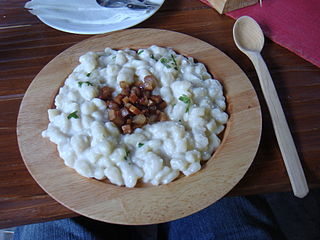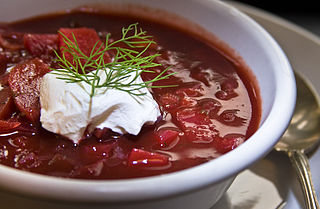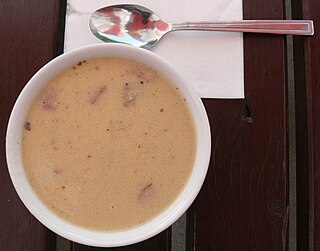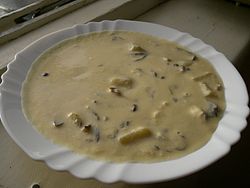
Tom kha kai, tom kha gai, or Thai coconut soup is a spicy and sour hot soup with coconut milk in Thai cuisine.

Polish cuisine is a style of food preparation originating in and widely popular in Poland. Due to Poland's history, Polish cuisine has evolved over the centuries to be very eclectic, and shares many similarities with other national cuisines. Polish cooking in other cultures is often referred to as à la polonaise, it often involves breadcrumbs fried in butter and poured over cooked vegetables.

Russian cuisine is a collection of the different dishes and cooking traditions of the Russian people as well as a list of culinary products popular in Russia, with most names being known since pre-Soviet times, coming from all kinds of social circles.

Ukrainian cuisine is the collection of the various cooking traditions of the people of Ukraine, one of the largest and most populous European countries. It is heavily influenced by the rich dark soil (chornozem) from which its ingredients come, and often involves many components. Traditional Ukrainian dishes often experience a complex heating process – "at first they are fried or boiled, and then stewed or baked. This is the most distinctive feature of Ukrainian cuisine".
Romanian cuisine is a diverse blend of different dishes from several traditions with which it has come into contact, but it also maintains its own character. It has been mainly influenced by Turkish and a series of European cuisines in particular from the Balkans, or Hungarian cuisine as well as culinary elements stemming from the cuisines of Central Europe.
Latvian cuisine typically consists of agricultural products, with meat featuring in most main meal dishes. Fish is commonly consumed due to Latvia's location on the eastern shore of the Baltic Sea.

Solyanka is a thick and sour soup of Russian origin that is common in Russia, Ukraine, Belarus, and other states of the former Soviet Union and certain parts of the former Eastern Bloc. It was one of the most popular dishes of the former East Germany.

Slovak cuisine varies slightly from region to region across Slovakia. It was influenced by the traditional cuisine of its neighbours and it influenced them as well. The origins of traditional Slovak cuisine can be traced to times when the majority of the population lived self-sufficiently in villages, with very limited food imports and exports and with no modern means of food preservation or processing.

Pörkölt is a meat stew which originates from Hungary, but is eaten throughout Central Europe.

Czech cuisine has both influenced and been influenced by the cuisines of surrounding countries and nations. Many of the cakes and pastries that are popular in Central Europe originated within the Czech lands. Contemporary Czech cuisine is more meat-based than in previous periods; the current abundance of farmable meat has enriched its presence in regional cuisine. Traditionally, meat has been reserved for once-weekly consumption, typically on weekends.

Belarusian cuisine refers to the culinary traditions native to Belarus. It shares many similarities with cuisines of other Eastern, Central and Northeastern European countries, based predominantly on meat and various vegetables typical for the region.

Smetana is the English-language name for the types of sour cream traditionally prevalent in Central, Eastern, and Southeastern Europe. It is a dairy product produced by souring heavy cream. It is similar to crème fraîche, but nowadays mainly sold with 9% to 42% milkfat content depending on the country. Its cooking properties are different from crème fraîche and the lighter sour creams sold in the US, which contain 12 to 16% butterfat. It is widely used in cooking and baking.
In West Slavic countries, as well as in Belarus, fermented cereals, such as rye, wheat, or oatmeal, are used to make soups. In Poland and parts of Belarus, rye is traditional for making żur; a variant made with wheat flour instead of rye is known in Poland as barszcz biały. Fermented oatmeal is a common ingredient in Belarus and in some regions of Poland. Fermented wheat or sourdough soups are also found in other western Slavic cuisines, in particular in the Slovak (kyslovka), Silesian (Sauermehlsuppe) and Czech (kyselo) cuisines.

Cream of mushroom soup is a simple type of soup where a basic roux is thinned with cream or milk and then mushrooms and/or mushroom broth are added. It is well known in North America as a common type of condensed canned soup. Cream of mushroom soup is often used as a base ingredient in casseroles and comfort foods. This use is similar to that of a mushroom-flavored gravy.

Soup is a primarily liquid food, generally served warm or hot, that is made by combining ingredients of meat or vegetables with stock, milk, or water. Hot soups are additionally characterized by boiling solid ingredients in liquids in a pot until the flavors are extracted, forming a broth. Soups are similar to stews, and in some cases there may not be a clear distinction between the two; however, soups generally have more liquid (broth) than stews.

Cabbage soup may refer to any of the variety of soups based on various cabbages, or on sauerkraut and known under different names in national cuisines. Often it is a vegetable soup, with lentils, peas or beans in place of the meat. It may be prepared with different ingredients. Vegetarian cabbage soup may use mushroom stock. Another variety is using a fish stock. There's also a preference to cook cabbage soup using a pork stock.

Zalewajka is a traditional rustic soup made of diced and boiled potatoes and overflowed with sour rye made from sourdough bread. It also often contains Polish sausage and dried mushrooms.














